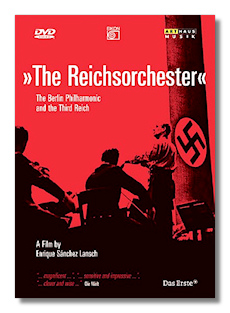
The Internet's Premier Classical Music Source
Related Links
- Wagner Reviews
- Latest Reviews
- More Reviews
-
By Composer
-
Collections
DVD & Blu-ray
Books
Concert Reviews
Articles/Interviews
Software
Audio
Search Amazon
Recommended Links
Site News
 DVD Review
DVD Review
The Reichsorchester

The Berlin Philharmonic and the Third Reich
- Richard Wagner: Die Meistersinger von Nürnberg: Act 1 Prelude
Berlin Philharmonic Orchestra/Wilhelm Furtwängler
Film directed Enrique Sánchez Lansch
Arthaus Music DVD 101453 100:00 Dolby Digital 2.0 Widescreen
This documentary explores the role played the Berlin Philharmonic before, during, and immediately after World War II – specifically, between 1933 and 45. There may have been some who described the Berlin Philharmonic during this period as a "Nazi orchestra," and this documentary was created to look more deeply into this attitude – to weigh its truth and falsehood, as it were.
Only two members of the Berlin Philharmonic during this period remained alive in 2004, when this documentary was begun: violinist Hans Bastiaan and double bassist Erich Hartmann. Both are interviewed extensively in this film. For the rest, Lansch is mostly dependent on interviews with sons and daughters, and on surviving film footage, which is by far the most interesting component of this documentary. The clips of Wilhelm Furtwängler, Erich Kleiber, and Sergiu Celibidache conducting the orchestra are treasurable.
The Philharmonic is not portrayed as a "Nazi orchestra" by any means. The truth of the matter is that it existed as an independent institution long before the rise of the Nazi party, who took it over (thereby solving its financial problems!) in 1933. There was little that was black-and-white about what happened next. Only a handful of its musicians were Jewish, and of course they lost their positions in the Philharmonic in the 1930s. By the same taken, only a handful of its members were card-carrying members of the Nazi party. The majority of the musicians found themselves in an ambiguous situation. This documentary portrays them neither as heroes or villains, but as human beings … albeit special ones, because they felt – perhaps naïvely! – that their first responsibility was to music. The film presents how the Philharmonic was used as a propaganda tool during this period, and how its members enjoyed special privileges. The most salient of these was exemption from combat, an exemption which remained in place right until the very end of the war, when Nazi Germany's world was falling down about its ears. Another was access to instruments … some of them apparently confiscated from Jewish musicians.
As a bonus, this DVD includes a complete filmed performance of the act I prelude from Die Meistersinger, with Furtwängler on the podium. This appears to have been filmed in a factory, and the camera often cuts to the faces of workers young and old, who listen to Wagner's music with rapt attention. In other words, this film is likely to have been used for propaganda purposes.
Much attention has been paid to conductors such as Furtwängler and Karajan during this period, but the Philharmonic itself seldom has been put under the lens in this manner. The Reichsorchester rectifies this error very capably, and it is a well-researched portrait of the place and time, but it is likely to be of interest mostly to the orchestra's admirers.
Copyright © 2008, Ray Tuttle




















